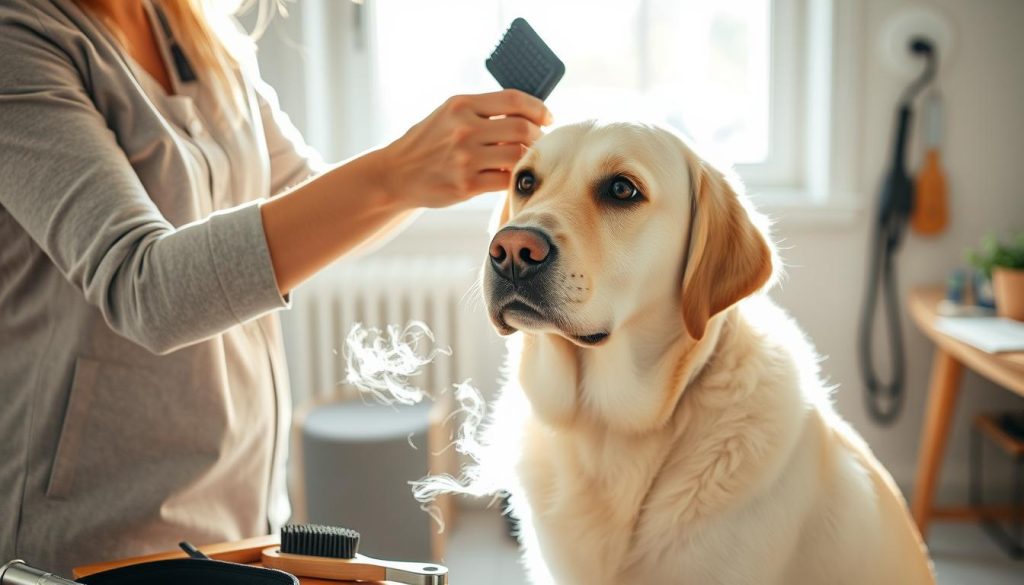Labrador Retrievers: Good for Allergy Sufferers?
In the United Kingdom, 30% of people have allergies to dogs1. Yet, Labrador Retrievers are still a favourite pet. For those with allergies, picking a “hypoallergenic” dog is crucial. But are Labradors good for people with allergies? This article will look into what makes a dog hypoallergenic, how allergies affect people, and the best breeds for those with sensitivities.
Key Takeaways
- Up to 20% of the population in Western countries are allergic to dogs2.
- Labradors, being heavy shedders, are not considered hypoallergenic1.
- Hypoallergenic breeds like Schnauzers and Poodles produce less dander and shed less1.
- Labrador Retrievers have significantly lower levels of the primary dog allergen, Can f 1, compared to low-shedding Poodles2.
- Homes with carpets tend to have higher levels of dog allergens than those with hardwood floors2.
Understanding Hypoallergenic Dogs
Looking for the perfect dog for someone with allergies? The term “hypoallergenic” dogs comes up a lot. But what does it mean, and why do people get dog allergies3?
What is a “Hypoallergenic” Dog?
People aren’t allergic to dog hair itself. They react to allergens on hair and dander3. “Hypoallergenic” dogs shed less or not at all3. This means less dander in the air and on surfaces, reducing allergy triggers.
But remember, no dog is completely hypoallergenic. All dogs have some hair and dander4.
Causes of Dog Allergies
Allergies happen when the immune system reacts to proteins in a pet’s urine, saliva, and dander5. For some, allergies can make it hard to be around dogs or other pets4.
“No dog can be truly hypoallergenic due to shedding dander, saliva, and urine being potential triggers for allergies.”4
Common Symptoms of Dog Allergies
Dog allergies can cause a lot of discomfort for pet owners6. Symptoms include sneezing, a runny nose, and itchy eyes and nose. Other signs are nasal congestion, postnasal drip, cough, and swollen face6. If you experience these, see your doctor right away6.
Dogs can also show signs of allergies like itching and ear infections6. They might have stinky ears, hair loss, and head shaking. Other signs include excessive licking of paws, hives, and face rubbing6. Seasonal allergies can change with the seasons, while food allergies cause stomach problems6.
It’s important to find out what’s causing a dog’s allergies6. Blood tests can check if a dog is allergic to certain foods6. RAST tests are less invasive but might not be as accurate6. The elimination trial method is a common way to test for food allergies6.
| Allergy Symptom | Description |
|---|---|
| Sneezing | Frequent, uncontrollable expulsion of air from the nose. |
| Runny Nose | Excessive nasal discharge, often clear in colour. |
| Itchy Eyes/Nose/Throat | A persistent, irritating sensation that compels the desire to scratch. |
| Nasal Congestion | Blockage or obstruction of the nasal passages, making breathing difficult. |
| Postnasal Drip | The sensation of mucus accumulating in the back of the throat. |
| Cough | A sudden, forceful expulsion of air from the lungs. |
| Swollen Face/Facial Pain | Inflammation and tenderness in the facial area. |
Managing dog allergies requires different strategies6. This includes using anti-allergy medication and preventing exposure to allergens6. It’s also important to treat any secondary skin infections6. To prevent exposure, limit walks and clean thoroughly6. Changing a dog’s diet should be done slowly and under vet supervision6.
Are Labrador Retrievers good for allergy sufferers?
Labrador Retrievers are loved for their friendly and smart nature. But, they’re not good for people with allergies7. They shed a lot, which can make allergies worse7. Their dander and saliva can also cause allergic reactions7.
Labradors have a thick coat that sheds a lot, especially twice a year8. This shedding releases dander, which is a big problem for dog allergy sufferers8. Even with regular grooming, they’re not safe for those with severe allergies78.
No dog breed is entirely allergen-free.7 But, some breeds like Poodles and Bichon Frises are better for people with allergies79. These dogs make fewer allergens, making them a better choice9.
Understanding the Shedding Habits of Labrador Retrievers
7 Labradors shed a lot, especially in spring and autumn7. They also shed a bit all year, releasing allergens7. Bathing can help, but no dog is completely free from allergens79.
8 Grooming and cleaning can help with Labrador shedding, but they’re not safe for severe allergies8. People with mild allergies might be okay with a Labrador, but they’re not hypoallergenic78.
“It is primarily the dander of a dog that causes the most problems for people with allergies.”7
In conclusion, Labradors are not the best for people with severe allergies789. If you’re looking for a hypoallergenic dog, consider Poodles or Bichon Frises79.
Controlling Labrador Shedding
Labrador Retrievers are loved for their friendly nature and loyalty. But, their heavy shedding can be tough for those with allergies10. There are ways to keep their coat healthy and lower allergens at home10.
Lukewarm Baths
Give your Labrador a lukewarm bath every 1-2 months. This helps remove dander, loose hairs, and allergens11. Use a gentle, sulphate-free shampoo to clean their coat without harming their skin12. This grooming can cut down on allergens in your home.
Change in Diet
Make sure your Labrador eats a balanced diet full of nutrients for a healthy coat and less shedding12. Add more amino acids, omega-3 and omega-6 fatty acids, vitamins, and minerals to their food12. This can make their coat stronger and reduce hair loss.
Daily Brushing
Brushing your Labrador every day is key for managing shedding11. It removes loose hairs, spreads natural oils, and keeps the coat clean. This means less vacuuming is needed11. Just a few minutes each day can greatly reduce hair in your home.
By taking these steps, you can control your Labrador’s shedding and lower allergens. This makes your home cleaner and healthier for those with allergies111012.

Allergy-Friendly Dog Breeds
While no dog is 100% hypoallergenic, some breeds are better for people with dog allergies13. These dogs often produce fewer allergens, shed less, or need regular grooming. This helps keep allergens under control. Let’s look at some of the best dog breeds for allergy sufferers.
Terriers
Terriers like the Bedlington, Kerry Blue, and Soft Coated Wheaten have fur that sheds less13. They need regular grooming to avoid matting. But their special fur makes them a good pick for those with allergies13.
Schnauzers
Schnauzers, including Giant, Standard, and Miniature, have hair that grows continuously14. They need regular grooming but shed very little14. Their low dander makes them a good choice for allergy sufferers14.
Poodles
Poodles, in Standard, Miniature, and Toy sizes, are great for those with allergies13. Their non-shedding, curly coats require regular grooming to prevent matting13. Their unique coat is a plus for allergy sufferers13.
Hairless Breeds
Hairless breeds, like the American Hairless Terrier, Chinese Crested Dog, and Xoloitzcuintli, are good options13. They might still cause allergies due to dander and saliva. But, they could work for some with dog allergies13.
Remember, even though these breeds are more allergy-friendly, reactions can still happen13. Keeping your dog clean, grooming regularly, and watching for signs of allergies is key13.
| Breed | Hypoallergenic Qualities | Grooming Needs |
|---|---|---|
| Terriers (Bedlington, Kerry Blue, Soft Coated Wheaten) | Coarse, wire-like fur that sheds less | Regular grooming to prevent matting |
| Schnauzers (Giant, Standard, Miniature) | Constantly growing hair, minimal shedding | Regular grooming to maintain appearance |
| Poodles (Standard, Miniature, Toy) | Non-shedding, curly coats | Regular grooming to prevent matting |
| Hairless Breeds (American Hairless Terrier, Chinese Crested, Xoloitzcuintli) | Minimal to no hair, but may still trigger allergies | Moderate grooming needs, including bathing |
“There is no breed of dog that is 100% hypoallergenic, but some breeds may be better suited for people with allergies.”13
Debunking the Hypoallergenic Myth
Many believe that some dog breeds are hypoallergenic, but this is not true15. The American Kennel Club (AKC) says all dogs have allergens. How people react to these allergens can differ a lot15. A 2011 study showed no big difference in allergens in homes with “hypoallergenic” dogs and those without.
Even dogs thought to be hypoallergenic, like Poodles and Bichon Frises, still have allergens16. A 2012 study found Poodles, despite being low-shedding, had high levels of allergens. Meanwhile, Labrador Retrievers, who shed more, had lower levels.
This means the idea of hypoallergenic dogs is mostly a myth. While some dogs, like Chihuahuas, might have fewer allergens15, keeping your home clean is key. Talking to a doctor and looking into treatments can also help with dog allergies15.

In short, the idea of hypoallergenic dogs is not real. All dogs, no matter the breed, can cause allergies in some people15. To deal with dog allergies, it’s important to be a responsible pet owner. This includes regular cleaning and getting the right medical help16.
Managing Dog Allergies at Home
Good Housekeeping Habits
For those with pet allergies, keeping the home clean is key to avoiding allergens17. About 37%-47% of American homes have a dog, and pet dander is found in every home, says the National Institutes of Health17. To lessen the effects of dog allergies, a few important steps can be taken.
- Regularly vacuum with a vacuum cleaner that has a HEPA filter17. Cleaning tips include sweeping, mopping floors, vacuuming rugs, and using a HEPA filter vacuum.
- Use a central air cleaner and filters on vents to help reduce dog dander in the air indoors17.
- Remove carpets, rugs, and drapes, and reduce dusty, overstuffed furniture, as these can harbour pet allergens17.
- Bathe the dog regularly to minimise the amount of dander shed18.
- Consider keeping the dog out of the bedroom, as this can help limit exposure to allergens during sleep17.
While these steps can help manage dog allergies at home, it’s important to remember that individual reactions can vary18. Symptoms of a dog allergy can range from mild to severe, and they may not appear immediately in individuals with low sensitivity19. Personal interaction with different dog breeds is crucial to determine individual allergic responses, as reactions can vary even within so-called “hypoallergenic” breeds19.
In addition to environmental modifications, over-the-counter medications and treatments can also be helpful in managing dog allergies17. Antihistamines, nasal corticosteroids, and allergy shots (immunotherapy) are among the options available to ease allergy symptoms and build tolerance to dogs over time18. Consulting with a healthcare professional can help determine the most suitable approach for individual needs.
| Medication | Examples |
|---|---|
| Antihistamines | Cetirizine (Zyrtec), Diphenhydramine (Benadryl), Fexofenadine (Allegra), Loratadine (Claritin) |
| Nasal Steroids | Budesonide (Rhinocort Allergy), Fluticasone (Flonase), Triamcinolone (Nasacort Allergy 24HR) |
| Allergy Shots | Immunotherapy to build tolerance to dog allergens |
By implementing these strategies and working closely with healthcare professionals, individuals with dog allergies can find effective ways to manage their symptoms and enjoy the companionship of their canine friends19. Taking steps to reduce exposure to pet allergens, such as grooming, frequent cleaning, and using air filtration systems, can help minimise allergy symptoms19.
Conclusion
Labrador Retrievers are great pets, but they’re not ideal for those with allergies because of their heavy shedding and dander20. Almost 10 million people in the US and about 20% of the world’s population are allergic to pets20. Even though some breeds are called “hypoallergenic,” research shows there’s no such thing as a truly hypoallergenic dog21.
Hypoallergenic breeds might cause fewer allergic reactions, but they still produce allergens. This can be a problem for those with sensitivities.
For people with allergies, breeds like Terriers, Schnauzers, Poodles, and some hairless breeds might be better21. These dogs shed less, produce less dander, and are often smaller. This can help reduce dog allergies at home21. But, they still need regular grooming to keep their coats healthy and reduce allergens21.
Choosing a dog for allergy sufferers is not straightforward20. It’s about picking the right breed, keeping a clean home, and using good allergy management. With the right steps, people with allergies can still have a furry friend by their side.
FAQ
Are Labrador Retrievers good for allergy sufferers?
No, Labrador Retrievers are not good for people with allergies. They shed a lot and produce dander. This can make allergies worse.
What is a “hypoallergenic” dog?
A “hypoallergenic” dog is one that usually doesn’t make allergies worse. These dogs don’t shed much or at all. This means less dander in the air and on surfaces.
What causes dog allergies?
Dog allergies happen when the immune system reacts to proteins in the pet’s urine, saliva, and dander.
What are the common symptoms of dog allergies?
Symptoms of dog allergies include sneezing, a runny nose, and itchy eyes. You might also have a cough or swollen face.
How much do Labrador Retrievers shed?
Labrador Retrievers shed a lot. They lose their winter coat in spring and grow a new one in autumn.
What are some tips for controlling a Labrador’s shedding?
To control a Labrador’s shedding, bathe them every 1-2 months. Make sure they eat well and brush them daily.
What dog breeds are considered more allergy-friendly?
Breeds like Terriers, Schnauzers, Poodles, and hairless dogs might be better for people with allergies.
Is there really such a thing as a “hypoallergenic” dog breed?
No, there’s no such thing as a truly hypoallergenic dog breed. Studies show no big difference in allergens between hypoallergenic and non-hypoallergenic dogs.
How can I manage dog allergies at home?
To manage dog allergies at home, keep the pet out of your bedroom. Use HEPA air filters and vacuum often. Wear a mask when vacuuming. Avoid carpets or steam clean them regularly.
Source Links
- Are Labrador Retrievers Hypoallergenic? (+Why You Should Care) – https://www.snowypineswhitelabs.com/blog/are-labrador-retrievers-hypoallergenic/
- No title found – https://www.akc.org/expert-advice/dog-breeds/do-hypoallergenic-dog-exist/
- Understanding Hypoallergenic Dog Breeds | L&L Info Hub – https://www.lordsandlabradors.co.uk/blogs/journal/understanding-hypoallergenic-dog-breeds?srsltid=AfmBOoqS2ZVbl3dpnEYa2sV0Kr-FB8b5362rDOa6f75sMXXmMQ3dJ5-_
- Best breeds for people with allergies – https://www.pitpat.com/doggy-insights/hypoallergenic-dogs-best-breeds-for-people-with-allergies/?srsltid=AfmBOooLH7ZMLXLxkFVHqeGlbZ1r1IelweyARt5_t63w85q2lPg9A5Ew
- 10+ Large Hypoallergenic Dog Breeds For Allergy Sufferers – Rebarkable – https://rebarkable.com/large-hypoallergenic-dog-breeds/
- The Difference Between Food Allergies and Environmental Allergies in Dogs – https://www.smalldoorvet.com/learning-center/wellness/food-seasonal-allergies-dogs
- Are Labrador Retrievers Hypoallergenic? The Truth Unveiled – Rocky Kanaka – https://rockykanaka.com/are-labrador-retrievers-hypoallergenic-the-truth-unveiled/
- Are Labrador Retrievers Hypoallergenic? – https://www.petssatisfaction.com/blogs/labrador-retriever-breed-guide/are-labrador-retrievers-hypoallergenic
- Are Any Dog Breeds Hypoallergenic? – https://health.clevelandclinic.org/are-any-dogs-hypoallergenic
- Are Labrador Retrievers Hypoallergenic? – https://blog.tryfi.com/labrador-retrievers-hypoallergenic/
- Hypoallergenic Dog Breeds: Is There Such a Thing? | VCA Animal Hospitals – https://vcahospitals.com/know-your-pet/hypoallergenic-dog-breeds-is-there-such-a-thing
- Labrador Retriever with Skin Allergies – Nom Nom – https://www.nomnomnow.com/learn/article/labrador-retriever-skin-allergies?srsltid=AfmBOopQ-dn6izs6-C7v5ipYhdB3WW4tmGyIZ762EM_2JMwtSf-vhitn
- No title found – https://www.akc.org/expert-advice/dog-breeds/hypoallergenic-dog-breeds/
- Best and Worst Dog Breeds for People With Allergies – https://www.everydayhealth.com/allergy-pictures/best-and-worst-dog-breeds-for-people-with-allergies.aspx
- Debunking the Myth: Are Chihuahuas Actually Hypoallergenic? – Rocky Kanaka – https://rockykanaka.com/debunking-the-myth-are-chihuahuas-actually-hypoallergenic/
- Debunking the Myth – Are Maltese Dogs Truly Hypoallergenic? – Rocky Kanaka – https://rockykanaka.com/debunking-the-myth-are-maltese-dogs-truly-allergy-friendly/
- All About Dog Allergies – https://www.webmd.com/allergies/dog-allergies
- Dog Allergies: Symptoms, Causes, and Natural Remedies – https://www.healthline.com/health/allergies/dog
- No title found – https://www.akc.org/expert-advice/home-living/can-i-have-a-dog-if-i-have-allergies/
- Hypoallergenic Dogs… Myth Busters. | Spot and Tango – https://whatthepup.spotandtango.com/hypoallergenic-dogs/
- Hypoallergenic Dog Breeds for People with Allergies – https://animalhotels.com/gb/blog/dogs/hypoallergenic-dog-breeds-for-people-with-allergies

